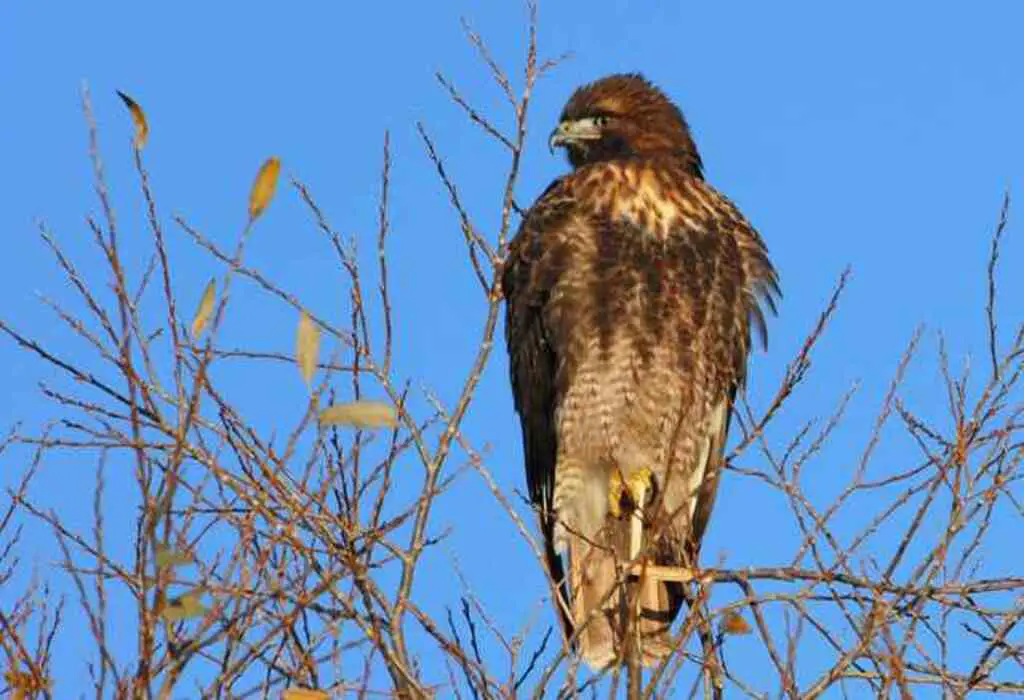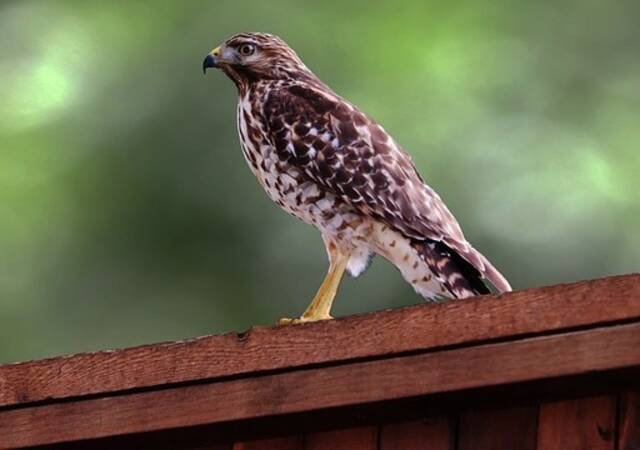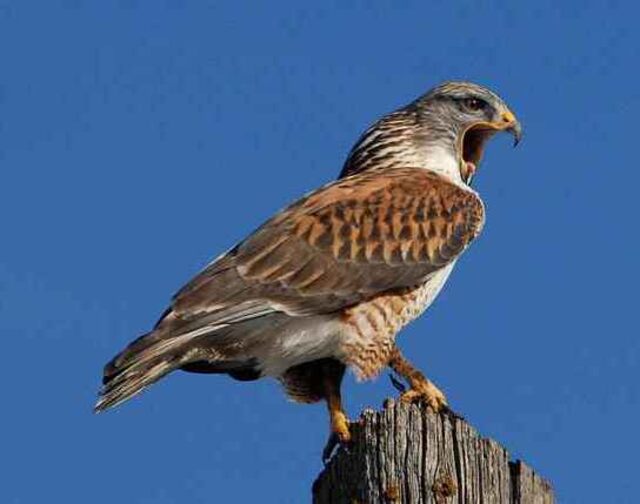How Do Hawks Sleep? Do they snuggle up in cozy nests like our fluffy pets or perch with an air of indifference? Well, prepare for a feathered surprise!
Hawks, those fascinating birds of prey with their sharp eyesight and impressive hunting skills, have their own peculiar sleep habits.
As diurnal creatures, they snooze at night, but what exactly happens during their slumber?
In this captivating article, we’ll delve into the unique sleeping preferences of hawks, their intriguing sleep positions, and the scientific explanations behind their balance and warmth during sleep.
We’ll also unveil the social behaviors of these majestic creatures and why protecting their sleeping areas is vital for both their survival and ecosystem balance.
Whether you’re an avid bird enthusiast, a dedicated conservationist, or simply curious about these amazing birds, join us on this soaring adventure into the world of hawk slumber!
Table of Contents
- 1 Key Takeaways
- 2 How Do Hawks Sleep?
- 3 Diurnal Birds: What Does it Mean?
- 4 The Sleeping Habits of Hawks
- 5 Comfort and Safety: Hawks’ Sleeping Preferences
- 6 Perching: Hawks’ Unique Sleep Position
- 7 Standing on One Leg: The Science Behind Hawks’ Balance
- 8 How Do Hawks Keep Warm While Sleeping?
- 9 Do Hawks Experience REM Sleep?
- 10 Sleeping Alone or in Groups: Hawks’ Social Behaviors
- 11 Protecting Hawks’ Sleeping Areas: Why It’s Important
- 12 Frequently Asked Questions
- 13 Conclusion
- 14 Author
Key Takeaways
- Hawks have unique sleeping habits shaped by their environment, physiology, and behavior, and sleep in an upright position with one eye open.
- They prefer elevated areas for roosting and utilize physiological adaptations to regulate their body temperature.
- Protection of sleeping areas is crucial for conservation efforts, as loss of habitat and disturbance of sleeping areas can have negative effects on hawk populations.
- Hawks are solitary and territorial, and their social behavior is affected by their sleeping habits, with some species exhibiting group dynamics during nesting season.
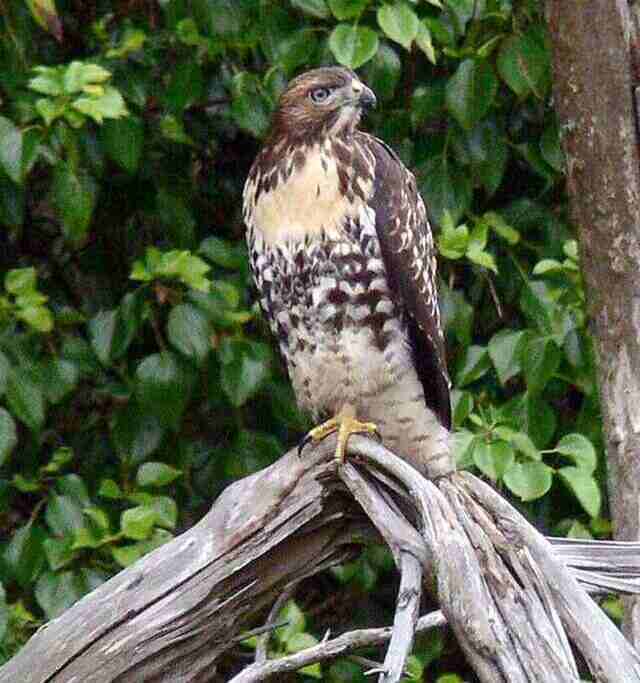
How Do Hawks Sleep?
Hawks sleep perched on branches or cliffs, with one leg tucked up, and their head turned backwards. This allows them to maintain balance and quickly take flight if needed.
They have a unique adaptation called unihemispheric slow-wave sleep, enabling one half of their brain to rest while the other remains alert for potential threats.
Diurnal Birds: What Does it Mean?
Diurnal birds, which are active during the day and sleep at night, have adapted their behaviors and physiological mechanisms to optimize their survival and performance in diurnal environments.
Unlike nocturnal birds that are active during the night, diurnal birds have evolved to be active during the day when there is more light to see their prey.
Their sleeping patterns are regulated by the circadian rhythm, which is an internal biological clock that regulates the sleep-wake cycle.
Sleep deprivation and sleep disorders can have a detrimental effect on their performance, making it harder for them to hunt and survive.
Diurnal birds have developed unique adaptations to sleep during the day, including shutting off one side of their brain while the other remains alert to detect predators and other threats.
Understanding the sleeping habits of diurnal birds, such as hawks, can provide insight into their daily routines and help us appreciate their unique behaviors and adaptations.
The Sleeping Habits of Hawks
Nocturnal birds of prey, such as the owl, have been observed to sleep in a more relaxed position with their heads tucked under their wings, whereas diurnal birds like hawks tend to sleep in a more upright position with their heads facing forward.
Hawks have specific sleeping patterns that are influenced by their roosting behavior and nesting habits.
They have adapted to sleep in a manner that ensures their safety, with one eye open and one eye closed to keep watch for potential predators.
Additionally, hawks have a unique ability to lock their talons onto branches, allowing them to sleep without the fear of falling.
Sleeping adaptations are also evident in their feathers, which offer insulation and protection from the elements.
It is fascinating to observe the sleeping habits of these powerful and free creatures, as they adapt to their environment to ensure their comfort and safety.
This leads us to explore further into the topic of comfort and safety: hawks’ sleeping preferences.
Comfort and Safety: Hawks’ Sleeping Preferences
Birds of prey have developed unique adaptations for ensuring their comfort and safety during sleep, particularly with regards to their roosting and nesting preferences.
Hawks, in particular, have specific sleeping posture and nesting habits that allow them to sleep soundly and safely.
They often prefer to roost in elevated areas such as trees, cliffs, or man-made structures like buildings or power poles.
Environmental factors such as wind, temperature, and light also play a role in their nesting choices.
Hawks are nocturnal predators and are therefore vulnerable to attacks from other predators during sleep.
Hence, they prefer roosting in areas that provide them with a clear view of their surroundings, enabling them to detect and defend against potential threats.
Sleep deprivation can have serious consequences for hawks, impacting their hunting and survival capabilities. Therefore, it is crucial that they have a safe and comfortable sleeping environment.
The subsequent section will discuss hawks’ unique sleep position, perching, and how it helps them sleep soundly and safely.
Perching: Hawks’ Unique Sleep Position
With a success rate of 20-30% in capturing prey, it is important to understand the unique perching position that hawks take during sleep.
Hawks primarily sleep while perched on a tree branch or other elevated structure, and their sleeping posture involves a talon grip on the branch and tucking one wing close to their body.
The other wing is also tucked in, but not as tightly as the first, allowing for balance and stability while sleeping.
Hawks also rotate their heads backwards, positioning their beaks towards their back, reducing the risk of injury from falling leaves or other debris.
This perching position is crucial for hawks to rest during the day, as they are diurnal predators and must be alert and ready to hunt during the day.
Their unique sleeping position not only provides safety and comfort, but also allows them to conserve energy and maintain a sense of freedom and independence.
Understanding the science behind the perching position is only the beginning of understanding the complexities of hawks’ sleeping habits, as the next section explores how hawks also maintain their balance while standing on one leg.
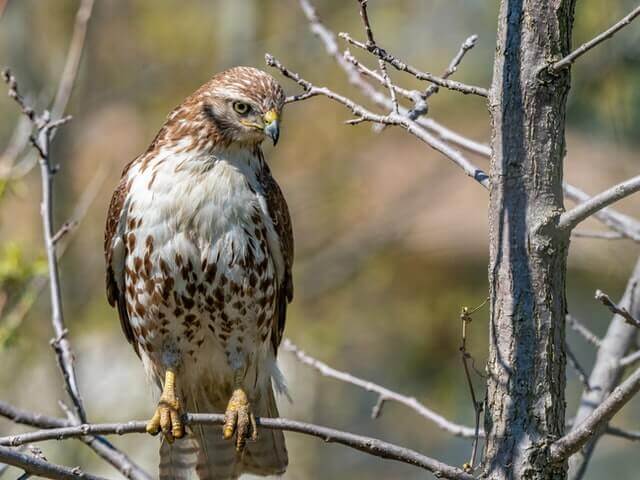
Standing on One Leg: The Science Behind Hawks’ Balance
Maintaining balance while standing on one leg is a crucial skill for hawks, and understanding the science behind it can shed light on their impressive physical capabilities.
Hawks have a unique ability to stand on one leg for extended periods without losing balance. This is possible due to their balance mechanics, which involve the use of leg muscles to keep the body steady.
When standing on one leg, hawks activate their hip and knee flexors, which help maintain balance by keeping the center of gravity above the supporting leg.
Additionally, hawks have developed a sleep cycle that allows them to maintain this balance even while sleeping.
Unlike mammals, birds have the ability to sleep with one eye open, which allows them to remain alert to potential predators while sleeping.
This strategy helps them avoid being caught off guard and losing their balance.
However, the constant need for vigilance can lead to sleep deprivation, which may affect their ability to maintain balance during the day.
In the next section, we will explore how hawks keep warm while sleeping without the use of blankets or pillows.
How Do Hawks Keep Warm While Sleeping?
During periods of rest, hawks utilize their unique physiological adaptations, similar to a self-contained furnace, to maintain a comfortable body temperature.
Hawks have a high metabolism, which allows them to generate and conserve heat. This is especially important during the colder months, when temperatures drop significantly.
To keep warm while roosting, hawks fluff up their feathers, creating an insulating layer that traps warm air next to their skin.
They also select roosting sites that provide shelter from the wind, such as in trees or on cliffs, and may use nesting materials to further insulate themselves.
Additionally, hawks have the ability to control their body temperature by constricting or dilating blood vessels in their legs and feet, which helps regulate heat loss.
These adaptations allow hawks to maintain a comfortable body temperature while sleeping, even in harsh weather conditions.
As we explore further into hawks’ sleeping patterns, we will delve into the question of whether or not hawks experience REM sleep.
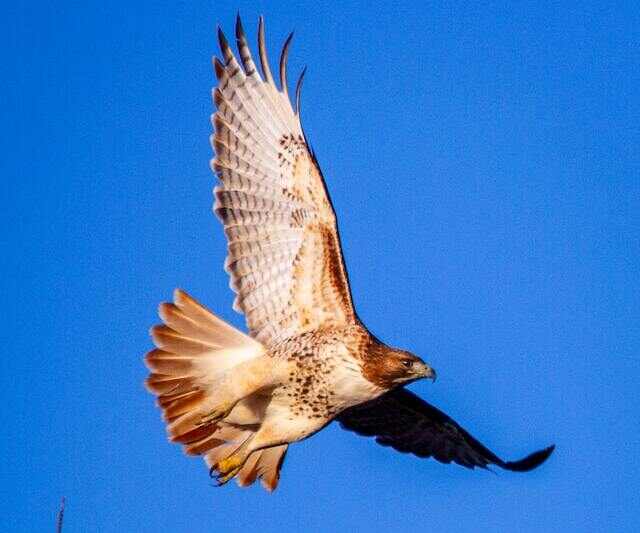
Do Hawks Experience REM Sleep?
Previous research has shown that hawks rely on a variety of methods to keep warm while sleeping, including tucking their heads under their wings and fluffing their feathers. However, little is known about the sleep patterns of these birds.
One area of interest is whether hawks experience REM sleep, the stage of sleep associated with dreaming.
While studies have shown that birds do experience REM sleep, it is unclear whether hawks specifically do so.
Additionally, sleep deprivation is known to have negative effects on cognitive function, so the impact of environmental factors on hawk sleep patterns is an important area of research.
Some studies have examined hawk sleep in captivity, but it is important to also study their sleep patterns in the wild.
Understanding the nature of hawk sleep may help shed light on the cognitive abilities of these birds and their adaptation to their environment.
The question of whether hawks dream remains unanswered, but the study of their sleep patterns is an important step in understanding the behavior and biology of these birds.
Moving forward, it will be interesting to examine whether hawks sleep alone or in groups and how this may affect their social behaviors.
Sleeping Alone or in Groups: Hawks’ Social Behaviors
Studying whether hawks prefer to sleep alone or in groups can provide insight into their social behavior and potentially evoke a sense of wonder about the complex relationships these birds may have.
Group dynamics can be observed in some species of hawks during nesting season, where they work together to build and defend their nests.
However, most hawks are solitary and territorial, preferring to hunt and roost alone.
Nocturnal predators such as owls are known to group together for safety, but hawks tend to avoid one another unless they are breeding or competing for resources.
Understanding hawks’ roosting preferences is important for conservation efforts, as loss of habitat and disturbance of sleeping areas can have negative effects on their populations.
In the next section, we will discuss why protecting hawks’ sleeping areas is crucial for their survival.
Protecting Hawks’ Sleeping Areas: Why It’s Important
After discussing the social behaviors of hawks and their sleeping habits, it is important to delve further into the topic of protecting their sleeping areas.
Hawks’ habitats have been increasingly threatened by human interference, making it crucial to focus on conservation efforts.
As hawks are known to have specific nesting habits and are vulnerable to predator threats, their sleeping areas must be safeguarded.
To illustrate the significance of protecting their sleeping areas, a table can be used to showcase the various predator threats and conservation efforts that have been implemented.
By understanding the importance of protecting hawks’ sleeping areas, we can ensure their survival and maintain the balance of our ecosystem.
Frequently Asked Questions
How do hawks mate?
Hawks exhibit complex nesting habits, with courtship displays and mating rituals varying among species. Reproductive biology is influenced by breeding season and environmental factors. Technical studies have observed mating behavior, but much remains unknown.
What do hawks eat?
Hawks are predators with diverse prey preferences and hunting strategies. They exhibit territorial behavior and nesting habits, and some species undertake long-distance migrations. Studying these aspects can inform conservation strategies for these captivating birds of prey.
How long do hawks live?
Hawk lifespan varies between species, with the average being 10–20 years and the maximum reaching up to 30 years. Breeding patterns can be monogamous or polygamous.
Factors affecting hawk survival include habitat loss, disease, and human activities. Predators of hawks include larger raptors and mammals.
How do hawks communicate with each other?
Hawks communicate with each other through a variety of vocalizations and body language, including wing flapping and head bobbing.
They also use hunting strategies and territorial behavior to establish and defend their nest locations. Their communication serves to maintain social bonds and coordinate activities.
What are the different species of hawks?
There are over 250 species of hawks globally, with varying nesting habits, hunting techniques, physical characteristics, migration patterns, and habitat preferences. One interesting fact is that the largest hawk species, the Harpy Eagle, has a wingspan of up to 7 feet.
Conclusion
In conclusion, the sleeping habits of hawks are a fascinating aspect of their behavior. These diurnal birds have unique preferences when it comes to sleeping, such as perching on high branches or standing on one leg.
Hawks are able to balance themselves while sleeping, and keep warm by fluffing their feathers and tucking their heads under their wings.
It is also possible that hawks experience REM sleep, just like humans and other animals.
Furthermore, hawks exhibit social behaviors when it comes to sleeping, sometimes sleeping alone or in groups.
It is important to protect their sleeping areas, as disturbance can disrupt their natural rhythms and affect their overall health.
Overall, observing the sleeping habits of hawks can provide valuable insights into the behavior and biology of these magnificent birds of prey.
The complexity and intricacy of their sleeping habits are truly remarkable, and serve as a reminder of the wonders of nature.

